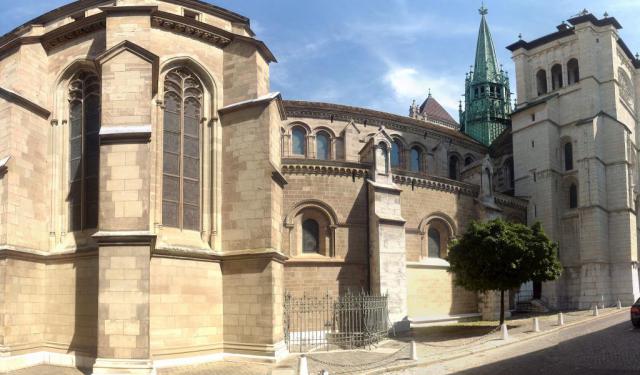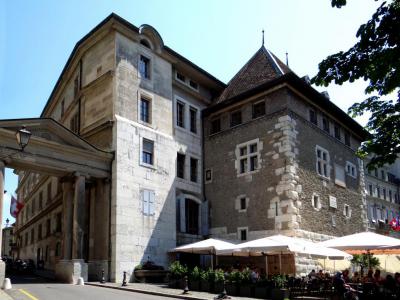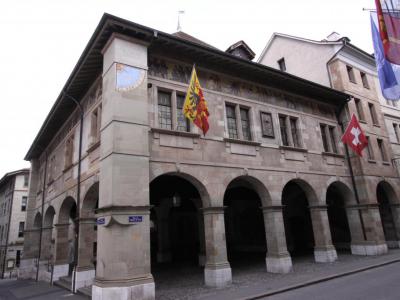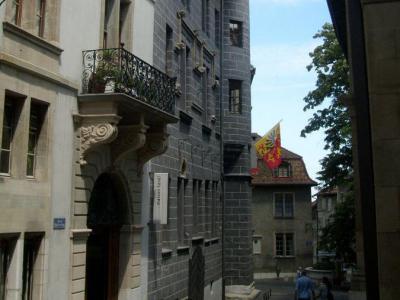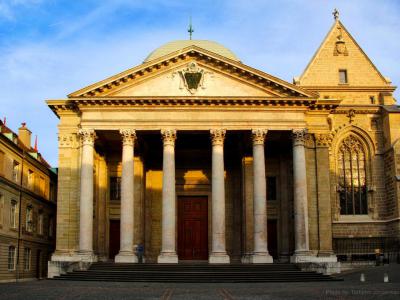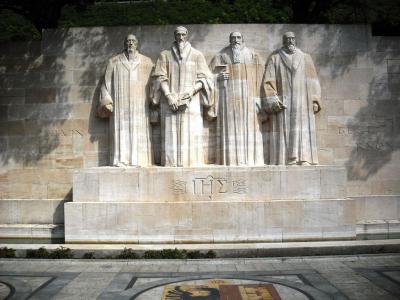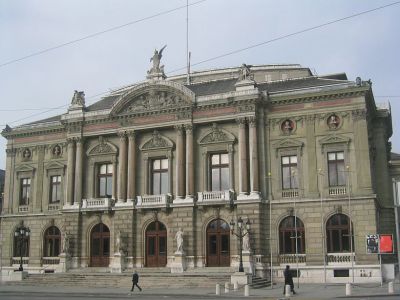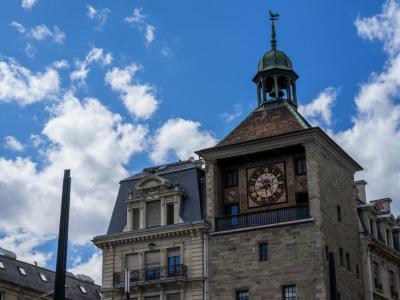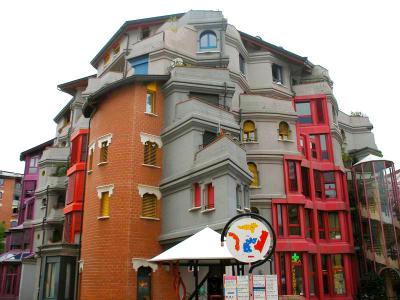Architectural Jewels (Self Guided), Geneva
Geneva, a city renowned for its diplomatic prowess and picturesque landscapes, boasts an array of architectural jewels. The remarkable medieval and more contemporary structures such as Geneva Town Hall (Hôtel de Ville), Saint Peter Cathedral (Cathedrale de Saint-Pierre), and Schtroumph Buildings, showing a mix of French and German influences, have captivated both locals and tourists for decades.
The Old Arsenal (Ancien Arsenal), a medieval fortress-like mansion turned museum, stands as a testament to Geneva's military history. The impressive collection of period weaponry and armor kept inside enables visitors to envision the city's past defenses.
Another interesting museum, Maison Tavel, marks one of the oldest houses in Geneva. It offers a fascinating journey through the city's evolution, with exhibits spanning from its medieval origins to modern times.
The Reformation Wall (Mur des Réformateurs) pays homage to Geneva's significant role in the Protestant Reformation. The larger-than-life statues of key reformers here are a powerful reminder of the city's historical influence.
The Grand-Théâter is a cultural gem where art and architecture harmoniously coexist. Its neoclassical façade hints at the splendid performances within, making it a hub for the city's artistic expression.
Equally charming a landmark, the Tower On The Island (Tour de l'Ile) is noted for its unique location amid the Rhône River.
So, why not embark on a journey through time and culture by exploring these locations now? Take this self-guided walk and let the city's architectural beauty leave an indelible mark on your heart.
The Old Arsenal (Ancien Arsenal), a medieval fortress-like mansion turned museum, stands as a testament to Geneva's military history. The impressive collection of period weaponry and armor kept inside enables visitors to envision the city's past defenses.
Another interesting museum, Maison Tavel, marks one of the oldest houses in Geneva. It offers a fascinating journey through the city's evolution, with exhibits spanning from its medieval origins to modern times.
The Reformation Wall (Mur des Réformateurs) pays homage to Geneva's significant role in the Protestant Reformation. The larger-than-life statues of key reformers here are a powerful reminder of the city's historical influence.
The Grand-Théâter is a cultural gem where art and architecture harmoniously coexist. Its neoclassical façade hints at the splendid performances within, making it a hub for the city's artistic expression.
Equally charming a landmark, the Tower On The Island (Tour de l'Ile) is noted for its unique location amid the Rhône River.
So, why not embark on a journey through time and culture by exploring these locations now? Take this self-guided walk and let the city's architectural beauty leave an indelible mark on your heart.
How it works: Download the app "GPSmyCity: Walks in 1K+ Cities" from Apple App Store or Google Play Store to your mobile phone or tablet. The app turns your mobile device into a personal tour guide and its built-in GPS navigation functions guide you from one tour stop to next. The app works offline, so no data plan is needed when traveling abroad.
Architectural Jewels Map
Guide Name: Architectural Jewels
Guide Location: Switzerland » Geneva (See other walking tours in Geneva)
Guide Type: Self-guided Walking Tour (Sightseeing)
# of Attractions: 8
Tour Duration: 2 Hour(s)
Travel Distance: 2.6 Km or 1.6 Miles
Author: john
Sight(s) Featured in This Guide:
Guide Location: Switzerland » Geneva (See other walking tours in Geneva)
Guide Type: Self-guided Walking Tour (Sightseeing)
# of Attractions: 8
Tour Duration: 2 Hour(s)
Travel Distance: 2.6 Km or 1.6 Miles
Author: john
Sight(s) Featured in This Guide:
- Hôtel de Ville (Geneva Town Hall)
- Old Arsenal (Ancien Arsenal)
- Maison Tavel House Museum
- Cathédrale de St. Pierre (Saint Peter Cathedral)
- Mur des Réformateurs (Reformation Wall)
- Grand-Théâter
- Tour de l'Ile (Tower On The Island)
- Schtroumph Buildings
1) Hôtel de Ville (Geneva Town Hall)
For over 500 years, Geneva’s Town Hall has been at the heart of local and even international political life. As the seat of the government of the Canton and the Republic of Geneva, this place has witnessed a number of events of great historic importance.
In 1864, the building’s Alabama Room saw the signing of the very first Geneva Convention, the founding act of the International Red Cross. Also, in 1872 it was here that the international arbitration court ended a long-standing conflict between the United States of America and Great Britain.
The 16th century building boasts three stories of neoclassical design, with a large courtyard and a huge paved ramp. The ramp is a unique cobbled spiral staircase built between 1555 and 1578 enclosed within a square tower, allowing direct access to the upper floors on horseback. Today, visitors can walk up in their forefathers' “hoof-steps” only on foot!
In 1864, the building’s Alabama Room saw the signing of the very first Geneva Convention, the founding act of the International Red Cross. Also, in 1872 it was here that the international arbitration court ended a long-standing conflict between the United States of America and Great Britain.
The 16th century building boasts three stories of neoclassical design, with a large courtyard and a huge paved ramp. The ramp is a unique cobbled spiral staircase built between 1555 and 1578 enclosed within a square tower, allowing direct access to the upper floors on horseback. Today, visitors can walk up in their forefathers' “hoof-steps” only on foot!
2) Old Arsenal (Ancien Arsenal)
The Old Arsenal (French: Ancien Arsenal) is a former militarily installation in the heart of Geneva's Old Town, located just a stone's throw from the Town Hall. Back in the day, it was used for storing arms and gun powder, but today serves a more peaceful function, housing the State Archives.
The building’s architecture, resembling a fortified mansion with five cannons set to defend the city against the attackers, recalls Geneva's distant warlike past. Under the Romans, this site was an open-air market, and was covered only in the early 15th century. In 1588, arcades were added, upon which a granary was built that was eventually transformed into a military depot, between 1720 and 1877.
Presently, underneath these arcades is a compact artillery museum with a collection of five period cannons, similar to those used to defend ramparts of the city, plus three colorful, battle-themed mosaics depicting key periods in the local history, namely: the arrival of Julius Caesar in 58 BC; the Fairs of the Middle Ages; and the reception of Huguenot refugees after the Revocation of the Edict of Nantes.
Also, each year on December 11 or the closest weekend, visitors to the Old Arsenal can treat themselves to some vegetable soup served here in commemorative bowls during the historic Escalade festival, celebrating the ill-fated attempt to conquer the Protestant city of Geneva by the Catholic Duchy of Savoy in 1602-1603.
The building’s architecture, resembling a fortified mansion with five cannons set to defend the city against the attackers, recalls Geneva's distant warlike past. Under the Romans, this site was an open-air market, and was covered only in the early 15th century. In 1588, arcades were added, upon which a granary was built that was eventually transformed into a military depot, between 1720 and 1877.
Presently, underneath these arcades is a compact artillery museum with a collection of five period cannons, similar to those used to defend ramparts of the city, plus three colorful, battle-themed mosaics depicting key periods in the local history, namely: the arrival of Julius Caesar in 58 BC; the Fairs of the Middle Ages; and the reception of Huguenot refugees after the Revocation of the Edict of Nantes.
Also, each year on December 11 or the closest weekend, visitors to the Old Arsenal can treat themselves to some vegetable soup served here in commemorative bowls during the historic Escalade festival, celebrating the ill-fated attempt to conquer the Protestant city of Geneva by the Catholic Duchy of Savoy in 1602-1603.
3) Maison Tavel House Museum
A unique testimony to medieval architecture in Switzerland, the Maison Tavel (Tavel House) is a listed historic building, one of the oldest in Geneva. The house was built in the 12th century by the Tavels, a noble Genevan family, hence the name. In 1334, it was reconstructed following a devastating fire, upon which it received an urban palace appearance. Having changed hands several times over the course of centuries between various influential local families, the house was finally acquired in 1963 by the City of Geneva, which undertook its thorough and exemplary restoration. In 1986, the property was turned into a museum of history of Geneva set to illustrate the city's urban development and various aspects of its daily life throughout centuries.
The exhibits – artifacts and historical objects focusing mostly on Geneva's medieval period – are spread over six floors and an underground section. In front of the museum there is a line of huge canons. The highlight of the exhibition, on the top floor, is a multimedia presentation on screen and a huge 3D map of Geneva outlining the city's history from the early days through the modern times, called "Geneva, history made-to-measure", with an audio provided in English, French, and German.
On the ground floor there is a reception desk. Free Wi-Fi is available throughout the building. Toilets and cloakroom, resembling a cave, are in the basement. There is also an exposition of historical measurements and machine weights, as well as an impressive 6,300-liter wooden barrel.
The exhibits – artifacts and historical objects focusing mostly on Geneva's medieval period – are spread over six floors and an underground section. In front of the museum there is a line of huge canons. The highlight of the exhibition, on the top floor, is a multimedia presentation on screen and a huge 3D map of Geneva outlining the city's history from the early days through the modern times, called "Geneva, history made-to-measure", with an audio provided in English, French, and German.
On the ground floor there is a reception desk. Free Wi-Fi is available throughout the building. Toilets and cloakroom, resembling a cave, are in the basement. There is also an exposition of historical measurements and machine weights, as well as an impressive 6,300-liter wooden barrel.
4) Cathédrale de St. Pierre (Saint Peter Cathedral) (must see)
The locale of the Cathedral of Saint Peter in Geneva has been the site of a cathedral and the seat of a bishop since the 4th century. The present cathedral was the work of the Prince-Bishop of the diocese, Arducius de Faucigny, in 1160. It was begun in the Gothic style, and there have been some changes since then.
The Cathedral of Saint Peter combines styles with a Neo-Classical Roman temple portico adjoined to a high-steepled Gothic edifice with a tall mullioned window. In 1535 French theologian John Calvin and the Reformation arrived in Geneva. Calvin adopted the cathedral as his home church, ushering in an age of architectural iconoclasm.
The cathedral was mostly stripped. The altars, all of the statues, and most paintings were destroyed or removed. The pulpit and some paintings were spared. The interior is spacious and plain, illuminated by hanging chandeliers. There are rows of benches and a few chapels. The aisles hold tombstones of 15th and 16th-century church dignitaries.
At the highest point of the Old Town, there is a stunning panorama for visitors hardy enough to brave the 157 steps of the north tower. The cathedral is often a venue for concerts. There is an archeological site in the crypt with artifacts of a 4th-century basilica. The 14th-century Chapel of the Maccabees should not be missed.
An enormous pipe organ is situated above the main entrance. It has the appearance of a red and gold crown. Loudspeakers are installed to magnify the already sonorous sound. If that is not enough, another, smaller organ is in the front on the left side. John Calvin's triangular stool is still next to the pulpit.
On the north side of the cathedral is the International Museum of the Reformation. The museum is open from Tuesday to Sunday from 10 am to 5 pm. A five-minute walk away is the Museum of Art and History. It has historical artifacts from the cathedral and the Saint Peter altarpiece painted by German artist Konrad Witz.
The Tower clock strikes every hour, followed by a tune on the glockenspiel, sometimes it's the Swiss National Anthem.
The Cathedral of Saint Peter combines styles with a Neo-Classical Roman temple portico adjoined to a high-steepled Gothic edifice with a tall mullioned window. In 1535 French theologian John Calvin and the Reformation arrived in Geneva. Calvin adopted the cathedral as his home church, ushering in an age of architectural iconoclasm.
The cathedral was mostly stripped. The altars, all of the statues, and most paintings were destroyed or removed. The pulpit and some paintings were spared. The interior is spacious and plain, illuminated by hanging chandeliers. There are rows of benches and a few chapels. The aisles hold tombstones of 15th and 16th-century church dignitaries.
At the highest point of the Old Town, there is a stunning panorama for visitors hardy enough to brave the 157 steps of the north tower. The cathedral is often a venue for concerts. There is an archeological site in the crypt with artifacts of a 4th-century basilica. The 14th-century Chapel of the Maccabees should not be missed.
An enormous pipe organ is situated above the main entrance. It has the appearance of a red and gold crown. Loudspeakers are installed to magnify the already sonorous sound. If that is not enough, another, smaller organ is in the front on the left side. John Calvin's triangular stool is still next to the pulpit.
On the north side of the cathedral is the International Museum of the Reformation. The museum is open from Tuesday to Sunday from 10 am to 5 pm. A five-minute walk away is the Museum of Art and History. It has historical artifacts from the cathedral and the Saint Peter altarpiece painted by German artist Konrad Witz.
The Tower clock strikes every hour, followed by a tune on the glockenspiel, sometimes it's the Swiss National Anthem.
5) Mur des Réformateurs (Reformation Wall) (must see)
Inaugurated in 1909, the Reformation Wall celebrates persons and events of the Protestant Reformation using bas-reliefs. On the grounds of the University of Geneva, the Reformation Wall marks the 400th anniversary of French reformer John Calvin's birth and the 350th anniversary of Calvin's founding of the University.
The wall is built into the Old City walls, emphasizing the role the city and its fortifications played in the drama of the Reformation. The monument was the result of a worldwide competition. Seventy-one designs were submitted. Four Swiss architects were picked: Charles Dubois, Alphonse Laverrier, Eugene Monod, and Jean Taillens.
Due to the close connections to Protestantism, the individuals most prominently depicted on the Wall were Calvinists; however, key figures in other theologies are also included. The sculptures were created by French artists Paul Landowski and Henri Bouchard. At the center of the monument stand four statues, each over 16 feet tall, representing the prominent figures of Calvinism: William Farel, John Calvin, Theodore Beza, and Kohn Knox. They wear scholastic robes and carry small bibles.
On the left of the group are three 10-foot figures of Fredrick Willam of Brandenburg, Willam the Silent, and Gaspard de Coligny. On the right are the figures of Roger Williams, Oliver Cromwell, and Stephen Bocskai. A motto declares in Latin: "After darkness, light."
The wall is built into the Old City walls, emphasizing the role the city and its fortifications played in the drama of the Reformation. The monument was the result of a worldwide competition. Seventy-one designs were submitted. Four Swiss architects were picked: Charles Dubois, Alphonse Laverrier, Eugene Monod, and Jean Taillens.
Due to the close connections to Protestantism, the individuals most prominently depicted on the Wall were Calvinists; however, key figures in other theologies are also included. The sculptures were created by French artists Paul Landowski and Henri Bouchard. At the center of the monument stand four statues, each over 16 feet tall, representing the prominent figures of Calvinism: William Farel, John Calvin, Theodore Beza, and Kohn Knox. They wear scholastic robes and carry small bibles.
On the left of the group are three 10-foot figures of Fredrick Willam of Brandenburg, Willam the Silent, and Gaspard de Coligny. On the right are the figures of Roger Williams, Oliver Cromwell, and Stephen Bocskai. A motto declares in Latin: "After darkness, light."
6) Grand-Théâter
The Grand Théâtre de Genève is not just a building where operas and performances take place, but it's also a significant cultural institution. This majestic structure, which stands tall at Place Neuve, was officially constructed in 1876. However, in 1951, it suffered partial destruction due to a fire but was subsequently restored and reopened in 1962 after undergoing extensive renovations. Today, it boasts the largest stage in Switzerland.
As an institution, the Grand Théâtre de Genève holds a prominent role in the French-speaking part of Switzerland, serving as the primary venue for opera, dance, recitals, concerts, and occasionally theater productions. Its history dates back to 1875 when the foundation stone was laid, and it was officially inaugurated in 1879 with a performance of Rossini's William Tell to open the season. The new building was considered one of the top ten opera houses in Europe, drawing architectural inspiration from the recently completed Palais Garnier in Paris with its Second Empire (Neo-Baroque) design.
The initial Grand Théâtre was not only opulently decorated but also featured cutting-edge technology for its time. This included a hydraulic-powered stage curtain supplied by the nearby Usine des Forces Motrices power plant on the Rhône River and the use of electric lights, which replaced gas lighting during performances.
However, tragedy struck on May 1, 1951, at 12:08 pm, during preparations for Wagner's Die Walküre. A devastating fire engulfed the theater, causing extensive damage to the stage, fly loft, grid, gangways, and their associated mechanical and electrical systems.
Following this catastrophic event, the City of Geneva initiated several reconstruction projects. The reconstruction efforts were carried out between 1958 and 1962, culminating in the grand reopening of the Grand Théâtre in December 1962, featuring the French version of Verdi's Don Carlos. Since its revival, the Geneva opera house has been led by several distinguished directors, including Marcel Lamy, Herbert Graf, Jean-Claude Riber, Hugues Gall, Renée Auphan, Jean-Marie Blanchard, and Tobias Richter.
As an institution, the Grand Théâtre de Genève holds a prominent role in the French-speaking part of Switzerland, serving as the primary venue for opera, dance, recitals, concerts, and occasionally theater productions. Its history dates back to 1875 when the foundation stone was laid, and it was officially inaugurated in 1879 with a performance of Rossini's William Tell to open the season. The new building was considered one of the top ten opera houses in Europe, drawing architectural inspiration from the recently completed Palais Garnier in Paris with its Second Empire (Neo-Baroque) design.
The initial Grand Théâtre was not only opulently decorated but also featured cutting-edge technology for its time. This included a hydraulic-powered stage curtain supplied by the nearby Usine des Forces Motrices power plant on the Rhône River and the use of electric lights, which replaced gas lighting during performances.
However, tragedy struck on May 1, 1951, at 12:08 pm, during preparations for Wagner's Die Walküre. A devastating fire engulfed the theater, causing extensive damage to the stage, fly loft, grid, gangways, and their associated mechanical and electrical systems.
Following this catastrophic event, the City of Geneva initiated several reconstruction projects. The reconstruction efforts were carried out between 1958 and 1962, culminating in the grand reopening of the Grand Théâtre in December 1962, featuring the French version of Verdi's Don Carlos. Since its revival, the Geneva opera house has been led by several distinguished directors, including Marcel Lamy, Herbert Graf, Jean-Claude Riber, Hugues Gall, Renée Auphan, Jean-Marie Blanchard, and Tobias Richter.
7) Tour de l'Ile (Tower On The Island)
One of the main cultural and architectural heritage sites of Geneva, Tour de l'Ile (“Tower On The Island”) is what's left of the fortified Castle on the Island completed in 1219 by the Bishop Aymé de Grandson, who once ruled the city as a Prince of the Holy Roman Empire. The castle played an important role in the defense of the city and was originally built to provide additional control over the strategic Rhone crossing. The castle was located on the small island which for many years was the only checkpoint en route between northern and southern Europe, thanks to the Island Bridge spanning the river banks. Julius Caesar, who met Divico, King of the Helvetii, here in 58 BC, had this bridge destroyed.
In 1842, renowned watchmaker Vacheron Constantin moved in the Tower On The Island replacing the previous tenants, the Geneva police department. His company remained here until 1875. After nearly a 140 year hiatus, in 2012, Vacheron Constantin firm re-established their quarters here again.
There has been a clock, in one form or another, on the top of the tower since 1538. Today it has been restored to the appearance it had when the first mechanism was replaced in 1680, complete with the Latin motto, "Post Tenebras Lux" (After Darkness, Light) on the dial.
The entire tower underwent extensive renovations, as well as archaeological excavation of its foundations, in 1898, and again in 1938 and 1957. Presently, several floors of the building are occupied by private apartments. On the right, just by the main entrance, there is a statue of the Genevan patriot Philibert Berthelier, who was beheaded in 1519 for defying the Dukes of Savoy; above him is a most interesting sundial: a Noon Mark sundial, with an analemma carved into the masonry. This particular type of sundial shows you when it's noon, any day of the year.
In 1842, renowned watchmaker Vacheron Constantin moved in the Tower On The Island replacing the previous tenants, the Geneva police department. His company remained here until 1875. After nearly a 140 year hiatus, in 2012, Vacheron Constantin firm re-established their quarters here again.
There has been a clock, in one form or another, on the top of the tower since 1538. Today it has been restored to the appearance it had when the first mechanism was replaced in 1680, complete with the Latin motto, "Post Tenebras Lux" (After Darkness, Light) on the dial.
The entire tower underwent extensive renovations, as well as archaeological excavation of its foundations, in 1898, and again in 1938 and 1957. Presently, several floors of the building are occupied by private apartments. On the right, just by the main entrance, there is a statue of the Genevan patriot Philibert Berthelier, who was beheaded in 1519 for defying the Dukes of Savoy; above him is a most interesting sundial: a Noon Mark sundial, with an analemma carved into the masonry. This particular type of sundial shows you when it's noon, any day of the year.
8) Schtroumph Buildings
Designed and built between 1982 and 1984 by Swiss architects Christian Hunziger, Robert Frei and Georges Berthoud, this odd-looking housing complex with whimsical details – irregular angles, curved walls and wrought iron railings without a single straight line, and with pops of color, both inside and out – was clearly inspired by Catalan architect Antoni Gaudì.
The sheer surrealism of the architecture prompted the locals to jokingly refer to it as the “Schtroumpf” buildings, a made-up word translated into Dutch as “smurf”, taken from a Belgian comic franchise centered on a fictional colony of small, blue, human-like creatures who live in mushroom-shaped houses in the forest.
The four buildings complex contains 170 city-subsidized apartments for rent, plus a number of office spaces on the ground floor, a pole dance studio, doctors’ offices, a small theater and a café.
Albeit open to viewing only from the outside, the peculiar buildings are quite fun to look at. On Thursdays, there is a very funky local market at La Place des Grottes.
The sheer surrealism of the architecture prompted the locals to jokingly refer to it as the “Schtroumpf” buildings, a made-up word translated into Dutch as “smurf”, taken from a Belgian comic franchise centered on a fictional colony of small, blue, human-like creatures who live in mushroom-shaped houses in the forest.
The four buildings complex contains 170 city-subsidized apartments for rent, plus a number of office spaces on the ground floor, a pole dance studio, doctors’ offices, a small theater and a café.
Albeit open to viewing only from the outside, the peculiar buildings are quite fun to look at. On Thursdays, there is a very funky local market at La Place des Grottes.
Walking Tours in Geneva, Switzerland
Create Your Own Walk in Geneva
Creating your own self-guided walk in Geneva is easy and fun. Choose the city attractions that you want to see and a walk route map will be created just for you. You can even set your hotel as the start point of the walk.
Chocolate Tour
Chocolate started to gain popularity in Switzerland in the early 16th century and has since evolved to become a highly appreciated Swiss commodity throughout the world. Almost every city or town in the country has at least one chocolate shop, and Geneva is by far no exception.
The local chocolate scene is a true delight for any cocoa enthusiast. Here, you'll find a handful of iconic... view more
Tour Duration: 1 Hour(s)
Travel Distance: 1.5 Km or 0.9 Miles
The local chocolate scene is a true delight for any cocoa enthusiast. Here, you'll find a handful of iconic... view more
Tour Duration: 1 Hour(s)
Travel Distance: 1.5 Km or 0.9 Miles
Geneva Introduction Walking Tour
The city of Geneva enjoys picturesque location at the southern tip of the expansive Lac Léman (aka Lake Geneva), surrounded by the Alps and Jura mountains, including the dramatic Mont Blanc peak.
The city was mentioned for the first time in Latin texts, by Caesar, with the spelling Genava, derived probably from the Celtic genawa- or genu- ("bend, knee"), in the sense of a bending... view more
Tour Duration: 2 Hour(s)
Travel Distance: 2.6 Km or 1.6 Miles
The city was mentioned for the first time in Latin texts, by Caesar, with the spelling Genava, derived probably from the Celtic genawa- or genu- ("bend, knee"), in the sense of a bending... view more
Tour Duration: 2 Hour(s)
Travel Distance: 2.6 Km or 1.6 Miles
Historical Churches
As the cradle of the Reformist movement in Europe led by theologian Jean Calvin, the city of Geneva has no shortage of religious sites representing a great deal of historical and cultural value. A dedicated Christian, a keen churchgoer, or simply one who is interested in objects of spirituality will find here quite a few temples worthy of attention.
Whether you're drawn to the austere... view more
Tour Duration: 1 Hour(s)
Travel Distance: 2.2 Km or 1.4 Miles
Whether you're drawn to the austere... view more
Tour Duration: 1 Hour(s)
Travel Distance: 2.2 Km or 1.4 Miles
Best Swiss Watch Shops Tour
When it comes to quality and precision, Swiss-made watches are known to be the best. Some of the world-renowned watch brands have been designed and masterminded in Geneva. The city's watch industry dates back to the 16th century, and since then has constantly developed to produce the most desired timepieces.
Geneva hosts a cluster of specialized shops that cater to the refined tastes of... view more
Tour Duration: 1 Hour(s)
Travel Distance: 1.2 Km or 0.7 Miles
Geneva hosts a cluster of specialized shops that cater to the refined tastes of... view more
Tour Duration: 1 Hour(s)
Travel Distance: 1.2 Km or 0.7 Miles
The Most Popular Cities
/ view all
